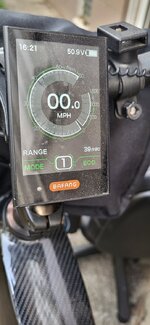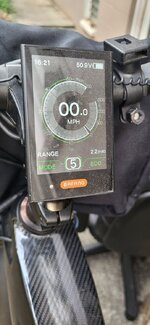You are using an out of date browser. It may not display this or other websites correctly.
You should upgrade or use an alternative browser.
You should upgrade or use an alternative browser.
52 volt battery
- Thread starter C177
- Start date
Rome
Well-Known Member
- Region
- USA
Here's an example of what I'm talking about. When my bike was new I experimented with range I use the display as reference for my actual range. At 50.9v it's telling me 22 miles, realistically on my range it's 15-20 miles of off road riding.
Attachments
tomjasz
Well-Known Member
- Region
- USA
- City
- Minnesnowta
I suspect that the Bosch BMS system doesn’t really charge to 100%. Likely a brilliant algorithm. Which would account for their incredible durability and cycle life.Most consider staying in the range of 20-80%. I've never gone below 6%, but go to 100% all the time on my Bosch batteries in 6 years. Brand of battery makes a difference.
6zfshdb
Well-Known Member
- Region
- USA
- City
- Northeast Pennsylvania
This topic has been discussed here often and there are many points of view. The answer depends on several factors.I have a juiced cross current x. How far can I use the battery before it stops. I have lithium batteries in a Motorhome. U can use them down to 10 percent and still be good. They are just 12 volts .
As previously suggested, run the bike until the low voltage cutoff shuts the bike down, measure the voltage and check your mileage. Keep in mind this voltage/mileage ratio will change under varied riding conditions like slope, temperature, riding surface and wind conditions. It's always best to use voltage rather than %. The chart posted above by AguassissiM is a good one and is a standard around here. I would check with the manufacturer and get their low voltage recommendations.
Do you need the extra range you get by discharging below 45V (20% on a 52V battery)? If not, don't do it. How many years do you want the battery to last? Do you plan to keep your bike forever or, like many here, get a newer model every so often.
The consensus of opinion is, frequently discharging below 20% can shorten battery life. Just how much depends on battery quality & design. Using the 80/20 rule can preserve a battery but is there any sense in "babying" a battery to the point where it outlasts the useful life of the bike? Keep in mind, a battery weakened by age & use can still be used as a range extender.
A real world example is this: I currently have six 52V batteries that I use in my three ebikes. The LVC in all of them cuts out at 43.7V or around 10% but I rarely discharge that low. I do need the extra range so I often go as low as 44.5V or around 15%. I charge to 100% but usually just before riding. For long term storage, I keep them between 40 and 60%. The batteries are 5 years old now with well over a hundred charge/discharge cycles and show no significant capacity loss.
BTW, welcome to the forum! You've come to the right place to ask your questions. Be prepared to get more information than you ask for as demonstrated by my post.
PedalUma
Well-Known Member
- Region
- USA
- City
- Petaluma, CA
The big rule is do not run it down all the way and leave it there: And do not charge it up all the way and leave it there. If going beyond the 20/80 rule, that is okay just as long as you quickly bring it back into that range quickly. Also avoid extreme temps for any length of time. You might do a short walk with a dog when it is 110F or -15F, but you wouldn't tie it to a tree and leave it there like that.
I have a 17.6 AH 52V battery. I experimented in the early days and could do maybe 20 miles at full power. Once it did poop out a block from home. On the other hand I did 74.8 mile on PAS 3 (out of 9) with constant pedaling. My Bike did die a half mile from the house but I have 2 really steep hills to climb at the end. I have a crossover bike with kinda skinny tires so it rolls well and will do 36 MPH. I have learned that the compromise is somewhere in the middle. I've done bunches of 40 to 50 mile rides with no issues. It does shut down around 43 volts like others said. The OP will find the sweet spot and enjoy.
Rome
Well-Known Member
- Region
- USA
Battery discussions are very interesting.
In fact when I log in another new thread on batteries exploding and causing deaths was posted.
Will it deter me from charging indoors to 100%? . My charging station the chargers are on all the time at the end of a ride I just simply stick the end that goes into the charging port of my bike.
. My charging station the chargers are on all the time at the end of a ride I just simply stick the end that goes into the charging port of my bike.
Plug play man.
In fact when I log in another new thread on batteries exploding and causing deaths was posted.
Will it deter me from charging indoors to 100%?
Plug play man.
6zfshdb
Well-Known Member
- Region
- USA
- City
- Northeast Pennsylvania
It's important when reading these battery fire posts that we keep the odds in mind. Most of us here are responsible e-bike owners and observe safe battery handling practices. When you exclude incidents involving batteries that are physically damaged, charged with jury rigged equipment or charged in an unsafe environment, the percentage is actually quite small.Battery discussions are very interesting.
In fact when I log in another new thread on batteries exploding and causing deaths was posted.
Will it deter me from charging indoors to 100%?. My charging station the chargers are on all the time at the end of a ride I just simply stick the end that goes into the charging port of my bike.
Plug play man.
I've learned a lot from the mistakes made in these battery fire posts and have adjusted my battery handling practices accordingly. Unfortunately, in the eyes of the general public, these stories only serve to further vilify e-bikes.
I only hope e-bikes can ride the growing wave of electric vehicle popularity instead of being regulated into oblivion.
PedalUma
Well-Known Member
- Region
- USA
- City
- Petaluma, CA
It sure is safer than something like gasoline. Just static can set gas off. The vapor is explosive. Yet, we have accepted that for 120 years. This is a much better way. And it is concentrated energy - that is why it works so well. There are batteries out there without management chips and with cheap A55 cells and construction because there is demand for cheep 5hit.
Rome
Well-Known Member
- Region
- USA
I have been a member of the forum almost 2 years now and I don't recall having read any member experiencing explosion or fire with their batteries. Batteries that won't charge or dead are common.
As for OP to determine cut off voltage of your battery you need to ride it until motor shutdown keeping track of miles ridden. It is also beneficial for evenning the cells base on what I have read from forum members.
My 48v when 100% charge is 54.9v. during my experiment with range at 43v motor started to intermittently cut off I was on highest sport mode level. I rode a total of 22 miles probably could have gone a couple more miles but I didn't feel like riding unpowered.
As for OP to determine cut off voltage of your battery you need to ride it until motor shutdown keeping track of miles ridden. It is also beneficial for evenning the cells base on what I have read from forum members.
My 48v when 100% charge is 54.9v. during my experiment with range at 43v motor started to intermittently cut off I was on highest sport mode level. I rode a total of 22 miles probably could have gone a couple more miles but I didn't feel like riding unpowered.
Similar threads
- Replies
- 10
- Views
- 935
- Replies
- 12
- Views
- 5K
- Replies
- 0
- Views
- 485



